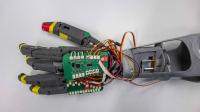Researcher from WUT in a team developing a bionic hand prosthesis
Krzysztof Mianowski, PhD, participated in a project with a team of researchers from Wrocław University of Science and Technology to create a bionic hand prosthesis aimed at supporting individuals with forearm amputations. The device is almost ready, with patient trials expected to start by the end of this year. Wrocław team’s work is led by Andrzej Wołczowski, PhD.
The prosthesis is designed for those with transradial (forearm-level) amputations, both single and double. This innovative prosthetic enables diverse grips and manipulations via advanced biosignal control. These signals are taken directly from the amputated limb stump and then analyzed using AI algorithms to interpret the user's intended actions. Beyond the AI algorithms, a significant challenge lies in the mechanical and informational interface between the patient and prosthesis, as well as creating a hand capable of dexterous gripping and object manipulation. Krzysztof Mianowski, PhD, contributed his biomechanical expertise to both aspects of the project.
"The result will be an active, electrically powered forearm prosthesis with a dexterous artificial hand controlled by potentials extracted from the remaining muscles of the forearm-stump patient. My role involved developing the mechanical components for both the active elbow and artificial hand prostheses, and creating prototypes using modern technologies," said Krzysztof Mianowski, PhD, of the Faculty of Power and Aeronautical Engineering at the Warsaw University of Technology.
How Does the Bionic Hand Prosthesis Work?
The prosthesis weighs about 500 grams, with a maximum grip force of around 100 N. The project enables prosthesis customization to fit the patient’s right or left hand, stump shape, and body profile.
The bionic hand features nine active degrees of freedom—independently driven joints allowing smooth, fluid movements. The prosthesis is controlled by biosignals collected noninvasively from the stump, providing more natural control than current market solutions. These signals can also be stimulated through "phantom limb" movements, aiding in neural rehabilitation and helping the patient cope with the sense of limb loss.
"The arm cuff is custom-made to match the patient's actual arm geometry, ensuring comfort. The designed artificial hand prosthesis is more versatile than existing solutions, with an enhanced kinematic scheme and greater degrees of freedom to handle complex manipulative tasks. Both the hand’s base and fingers have built-in pressure and position sensors, providing the patient with 'artificial sensation' and more precise control during complex object manipulation," explains Krzysztof Mianowski, PhD.
For more information about the project, visit the Wrocław University of Science and Technology’s website








